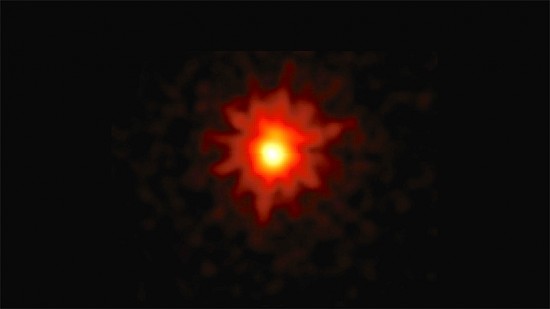
Glow from DG Canum Venaticorum about an hour after the detection of a “super flare”. Credit: NASA’s Goddard Space Flight Center.
Aug 25, 2015
Stellar flares are seen in unexpected places.
In a September 30, 2014 press release, NASA officials from the Goddard Space Flight Center announced that their SWIFT satellite detected a stellar flare with X-ray emissions larger than anything they expected to witness from DG Canum Venaticorum, a “normal” red dwarf star.
Launched in November of 2004, SWIFT is designed to detect the output from Gamma Ray Bursters (GRB) that are said to light up with energies near the billion-electron-volt range. In previous Picture of the day articles, the GRB phenomenon was shown to be local to the Milky Way and not as energetic as astronomers believe. Rather than incredible explosions from “the edge of the universe”, what they see are moderately sized detonations from “exploding double-layers” within our own galaxy. (Alfvén, Hannes, “Double Layers and Circuits in Astrophysics“).
The instruments onboard SWIFT are sensitive to lower-level radiation, as well as gamma rays, so it has the ability to “see” other high-frequency electromagnetic radiation (EMR) bands. Coupled with the WIND satellite’s equipment, NASA is conducting a scan for EMR from 10,000 electron volts to 100-billion electron volts. Thus, the combined resolution of both instruments enabled them to locate DG Canum Venaticorum’s X-ray blast in the local stellar neighborhood.
In giant “lightning flashes” of X-rays, stellar flares discharge vast quantities of matter (moving at relativistic speeds) in mere seconds. One of the major questions that astrophysicists have yet to answer is how flares creates such highly energetic emissions?
Earlier last century, Hannes Alfvén found a clue when he was contracted by the Swedish Power Company to investigate some serious accidents that had occurred. A few of the rectifiers used in the power transmission circuits had exploded for no apparent reason. When the rectifiers shorted-out more energy was released than was contained by the plasma flow inside them because the power from the entire 900 kilometers of transmission line instantly passed through the devices. The result was a catastrophic failure and extensive damage. Alfvén identified the cause as unstable double layers within the plasma flow.
The circuit connecting DG Canum Venaticorum (and other stars) is of unknown length, but probably extends for thousands of light-years. How much electrical energy might be contained in such magnetically confined “transmission lines”? No one knows, but astronomers are continually “surprised” by the incredible detonations that they observe from galactic jets, supernovae and stellar flares.
It will serve all students of cosmic electricity to remember Alfvén’s comments: “Double layers in space should be classified as a new type of celestial object (one example is the double radio sources). It is tentatively suggested that X-ray and gamma ray bursts may be due to exploding double layers.” (See in locus).
Stephen Smith












